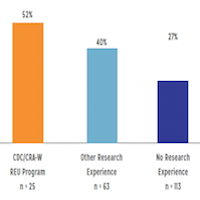Mentoring the Whole STEM Person: Advancing LGBTQ+ students and professionals
January is National Mentoring Month, a great time to learn how mentoring can help support students and professionals in computing research, and in Science, Technology, Engineering, and Mathematics (STEM) more generally. Mentoring is especially important for individuals in STEM from underrepresented groups in promoting persistence and success in education and professional settings. Effective mentoring programs help mentors and mentees consider various attributes of their identities and experience, like race, ethnicity, socio-economic status, and educational background, which may influence their persistence and success. Although effective programs aim to support the whole person, gender identity and expression and sexuality orientation are often overlooked.
Improving the knowledge, cultural competency, and mentoring skills of educators and professionals who mentor lesbian, gay, bisexual, transgender, queer, intersex, and asexual (LGBTQ+) students and early career professionals will address an area of unmet need and complement other efforts to attract and retain LGBTQ+ people in STEM fields. Since 2006, the National Organization of Gay and Lesbian Scientists and Technical Professionals (NOGLSTP) and MentorNet, a division of Great Minds in STEM, have collaborated to provide LGBTQ+ mentors and mentees in STEM fields with access to one-to-one virtual mentorships.
 NOGLSTP and MentorNet are collaborating on the creation of evidence-based mentoring resources for the LGBTQ+ STEM community and are committed to broad dissemination of these resources. We welcome others interested in collaboration.
NOGLSTP and MentorNet are collaborating on the creation of evidence-based mentoring resources for the LGBTQ+ STEM community and are committed to broad dissemination of these resources. We welcome others interested in collaboration.
LGBTQ+ individuals face unique challenges in pursuing STEM degrees and careers and throughout all stages of career development (Gedro, 2009). Recent work indicates that LGBTQ+ individuals think about leaving computer science degree programs to a greater degree than non-LGBTQ+ individuals, due to LGBTQ+ students’ relatively lower sense of belonging (Stout & Wright, in press). Although research has shown the negative impact that stigma plays on LGBTQ+ people in education and the workplace, targeted interventions have been shown to improve professional climates. Studies demonstrate how hetero-normative assumptions in professional norms and workplace socialization increase pressure on LGBTQ+ individuals to downplay their gender identity and sexual orientation or to hide their queer identities entirely. In contrast, employees who disclose their identities at work report higher job satisfaction and lowered anxiety (Griffith & Hebl, 2002).
A growing body of research demonstrates how LGBTQ+ individuals benefit from the individualized support of mentorships in the academy and the workplace. LGBTQ+ undergraduate mentees matched with LGBT mentors experience benefits such as personal support during various phases of their development as a sexual minority, increased access to community resources, and increased connection to their universities (Ross, 2005). Students with mentors in the workplace are found to have higher academic achievement than those without mentors (Hamilton & Hamilton, 2013), and the presence of mentors for 25- to 31-year olds is linked with higher skill levels in employees (McDonald & Lambert, 2011). Mentors’ vital functions include skill instruction, role modeling, and individualized support (Hamilton and Hamilton, 2013).
Mentoring is not a panacea or one-size-fits-all endeavor (DuBois, Portillo, Rhodes, Silverthorn, and Valentine, 2011; Rhodes, 2002). Mentoring services must be designed to reflect the unique needs and circumstances of the individuals served (Rhodes, 2005). Further, mentoring, when not done intentionally, may cause more harm to a mentee than if he or she had never been in a mentorship (DuBois, et al., 2011). Adherence to evidence-based practices, which include guidance for recruitment, screening, matching, training, and case management support, help ensure that mentoring services are of the highest quality (MENTOR, 2009). The intersection between personal and professional identity is linked for LGBTQ+ populations, therefore mentoring best practices should incorporate awareness of this intersection.
The findings of the national Queer in STEM study (Yoder and Mattheis, 2015) support the benefits of mentorships found in other studies (see Eagan, et al., 2013). Interestingly, few respondents could identify at least one openly LGBTQ+ teacher or faculty member during their STEM education. Many also described feeling pressure to separate their personal and professional lives, revealing a general culture of silence about many aspects of personal identity in STEM fields. NOGLSTP and MentorNet advocate mentoring practices that increase awareness in the STEM community about gender identity and expression and sexual orientation and that empower LGBTQ+ students and professionals to bring their whole self to their educations and careers. Mentorships can help individuals from the LGBTQ+ populations, and from other underrepresented groups, build relationships of mutual trust and support that strengthen their professional networks and that support their persistence and success throughout their STEM educations and careers.
References:
DuBois, D. L., Portillo, N., Rhodes, J. E., Silverthorn, N., & Valentine, J. C. (2011). How Effective Are Mentoring Programs for Youth? A Systematic Assessment of the Evidence. Psychological Science in the Public Interest, 12(2), 57 91. http://doi.org/10.1177/1529100611414806
Gedro, J., & Wang, J. (2013). Creating Civil and Respectful Organizations Through the Scholar-Practitioner Bridge. Advances in Developing Human Resources, 15(3), 284-295.
Griffith, K.H. & Hebl, M.R. (2002). The disclosure dilemma for gay men and lesbians: “Coming out” at work. Journal of Applied Psychology, 87(6), 1191-1199.
Hamilton, S.F. & Hamilton, M.A. (2013). Work and service-learning. In D.L. DuBois & M.J. Karcher (Eds.). Handbook of Youth Mentoring (pp. 291-300) Thousand Oaks, CA: Sage.
Mattheis, A. & Yoder, J.B. (2014). Queer in STEM: National study overview and implications for higher education. NASPA Excellence in Practice Knowledge Communities. http://apps.naspa.org/files/2014Spring-KC-Publication-Final.pdf
McDonald, S., & Lambert, J. (2011). The long arm of mentoring: Informal adolescent mentoring and employment outcomes in young adulthood. Unpublished paper prepared for the US Department of Labor.
MENTOR, 2009. Elements of effective practice for mentoring (3rd ed.). Alexandria, VA: Author. Retrieved from http://www.mentoring.org/program_resources/element_and_toolkits
Rhodes, J. E. (2002). Stand by me: The risks and rewards of mentoring today’s youth (First). Cambridge, MA: Harvard University Press.
Rhodes, J. E. (2005). A model of youth mentoring. In D. L. DuBois & M. J. Karcher (Eds.), The Handbook of Youth Mentoring (First, pp. 30–43). Thousand Oaks, CA.: Sage Publications.
Ross, F. E. (2005). Achieving cultural competence: The role of mentoring in sexual minority identity development (Doctoral dissertation, Bloomington, Ind.: Indiana University).
Stout, J. G. & Wright, H. M. (in press). Lesbian, Gay, Bisexual, Transgender, and Queer Students’ Sense of Belonging in Computing: An Intersectional Approach, Computing in Science and Engineering.
Yoder, J.B. & Mattheis, A. (in press). Queer in STEM: Results of a national survey. Journal of Homosexuality.
Authors:
Allison Mattheis, Ph.D., assistant professor, Division of Applied and Advanced Studies in Education, California State University, Los Angeles, amatthe5@calstatela.edu
Rochelle Diamond, research biologist, California Institute of Technology and Chair, NOGLSTP, diamond@caltech.edu
Mary Fernández, president, MentorNet, a Division of Great Minds in STEM, mfernandez@greatmindsinstem.org









